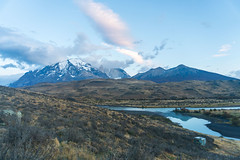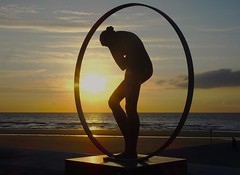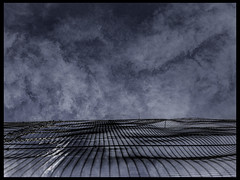The above map was created by Paul Butler, a data infrastructure engineering intern at Facebook. Paul was interested in seeing how geographical and political borders effect where Facebook users live in relation to their Facebook friends, and set off to create a visualization of which cities had a lot of connections between them.
Launch Party at World’s First Private SpacePort

Sixteen months after breaking ground in Las Cruces, New Mexico, the world’s first commercial spaceport “Spaceport America” celebrated this weekend with a launch party for the facility’s two-mile-long runway (watch the ceremony here). A partnership between the State of New Mexico and Richard Branson’s Virgin Galactic, the spaceport has been providing commercial satellite launch services for the past few years, and will soon begin its much-anticipated space tourism flights, ferrying lucky (and wealthy) customers into suborbital space for a few minutes of weightlessness and a remarkable view of our planet.
Glowing LED Tattoos, The Next Big Thing in Body Modification?

Although they’ve seen a surge in popularity over the past decade, tattoos are basically created the same way they have been for eons. Ink forced under the skin by a sharp implement. Now, thanks to an international team of researchers, led by John Rogers at the University of Illinois, subdural illumination could soon be coming to a tattoo parlor near you.
Radical Cartography Maps Chicago’s Racial Divides and Nuclear Explosions

Radical Cartography is the website of historian and cartographer, Bill Rankin. Currently working on a PhD at Harvard, Rankin has done considerable research on the changing technologies of cartography (map making) and navigation in the twentieth century. His mapping activity is focused on reimagining everyday urban and territorial geographies by pushing techniques of statistical information design and rethinking everyday cartographic conventions.
Rankin’s maps help us visualize racial divides in Chicago (as featured below), university campuses surrounding Boston, building heights in Manhattan, the spread of agriculture over the past 300 years, and the location of every nuclear explosion around the world since 1945.
“Bus Stop of the Future” Can Sense its Surroundings
 Imagine if your local bus stop enabled you to check your e-mail, share community information on a digital message board or check the weather forecast? Even better, what if it could tell you the exact location and time of arrival of that bus that you’re waiting for?
Imagine if your local bus stop enabled you to check your e-mail, share community information on a digital message board or check the weather forecast? Even better, what if it could tell you the exact location and time of arrival of that bus that you’re waiting for?
Jason Schwartzman Demos the Hell Out of the New Yorker iPad App

The new App has everything that is in the print edition and more: extra cartoons, extra photographs, videos, audio of writers and poets reading their work.
Telegram -(Stop)-

You’re inundated with digital communications, email, text messages, MMS. Wouldn’t be nice to get an actual letter in the mail on occasion?
Not nostalgic enough for you?
How about a telegram? Old, old school. A new online service enables you to send an honest-to-goodness telegram to anyone, anywhere.
Free and Simple Email Reminders with FollowUpThen.com
You’ve just sent a pressing email to a colleague, a friend, an alter ego. One to which you’d expect a follow-up or return message in a timely manner. But it’s Thursday night. And Thursday night, as we all know, is the new Friday night. Your recipient might not be paying a whole lot of attention to their crackberry. Perhaps it would be helpful to all if your (insert euphemism) was to receive a follow-up reminder in a couple of days?
In 2021 You’ll Enjoy Total Recall

Upgrading our memory is a matter of improving our recording and retrieving abilities. At the current pace of miniaturization, camera components could be made tiny enough to fit in a contact lens (A) in just a few years. A high-precision microphone could fit in your ear (B). And the data could be downloaded to a searchable handheld gadget (C) Big Sesh Studios
Humans naturally have the power to remember almost two bits of information per second, or a few hundred megabytes over a lifetime. Compared with a DVD movie, which holds up to 17 gigabytes, that´s nothing. Worse, you might easily recall the 40-year-old dialogue from Hogan´s Heroes yet forget your mom´s birthday. Or memorize reams of sports stats while spacing out on work you completed just last week.
It’s a problem that’s been bothering Gordon Bell for almost as long as he can remember. In 1998 Bell, a senior researcher at Microsoft, began digitally capturing his entire life for a project he calls MyLifeBits.
ProDigits: World’s First Bionic Hand
The ProDigits bionic hand, is made by Touch Bionics in Livingston, Scotland. The device can replace any or all fingers on a hand; each replacement digit has a tiny motor and gear box mounted at the base. Movement is controlled by a computer chip in the prosthesis.













